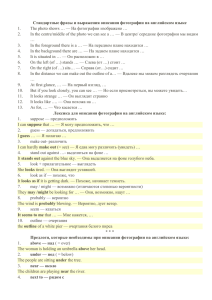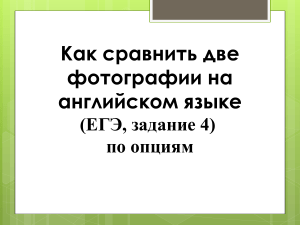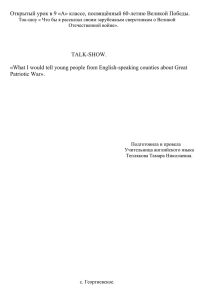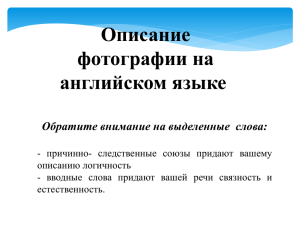Устная часть ЕГЭ Примерное описание фотографии (ЕГЭ
реклама
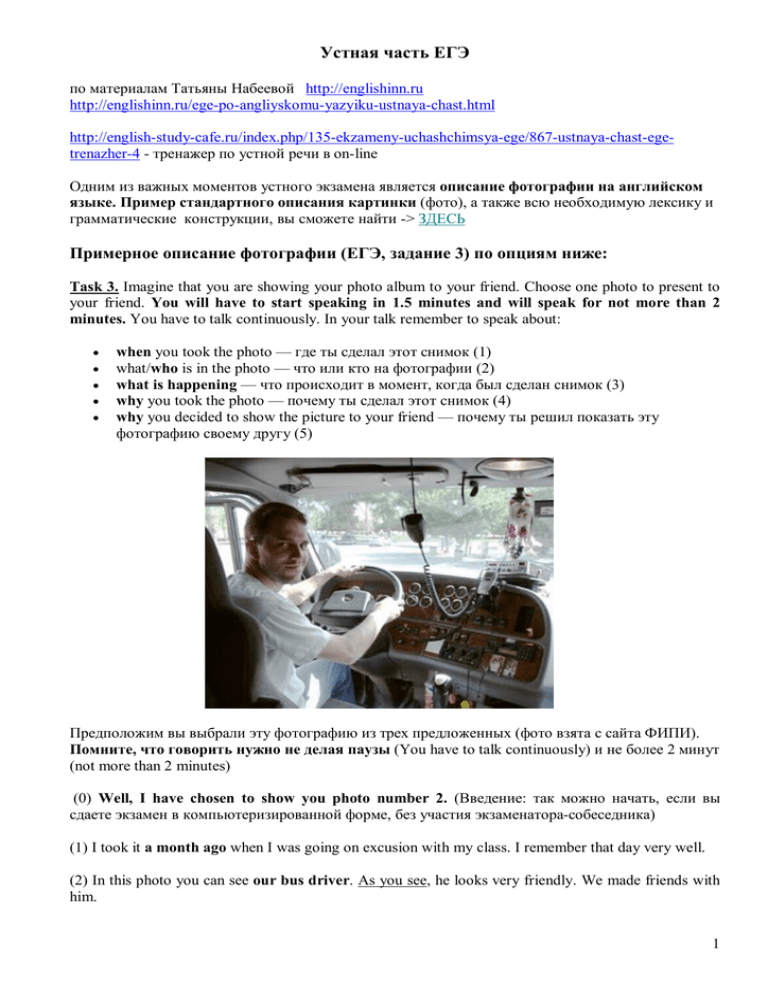
Устная часть ЕГЭ по материалам Татьяны Набеевой http://englishinn.ru http://englishinn.ru/ege-po-angliyskomu-yazyiku-ustnaya-chast.html http://english-study-cafe.ru/index.php/135-ekzameny-uchashchimsya-ege/867-ustnaya-chast-egetrenazher-4 - тренажер по устной речи в on-line Одним из важных моментов устного экзамена является описание фотографии на английском языке. Пример стандартного описания картинки (фото), а также всю необходимую лексику и грамматические конструкции, вы сможете найти -> ЗДЕСЬ Примерное описание фотографии (ЕГЭ, задание 3) по опциям ниже: Task 3. Imagine that you are showing your photo album to your friend. Choose one photo to present to your friend. You will have to start speaking in 1.5 minutes and will speak for not more than 2 minutes. You have to talk continuously. In your talk remember to speak about: when you took the photo — где ты сделал этот снимок (1) what/who is in the photo — что или кто на фотографии (2) what is happening — что происходит в момент, когда был сделан снимок (3) why you took the photo — почему ты сделал этот снимок (4) why you decided to show the picture to your friend — почему ты решил показать эту фотографию своему другу (5) Предположим вы выбрали эту фотографию из трех предложенных (фото взята с сайта ФИПИ). Помните, что говорить нужно не делая паузы (You have to talk continuously) и не более 2 минут (not more than 2 minutes) (0) Well, I have chosen to show you photo number 2. (Введение: так можно начать, если вы сдаете экзамен в компьютеризированной форме, без участия экзаменатора-собеседника) (1) I took it a month ago when I was going on excusion with my class. I remember that day very well. (2) In this photo you can see our bus driver. As you see, he looks very friendly. We made friends with him. 1 (3) We were going to the State Darwin Museum and on the way he told us a lot of facts about wild life. By the way, he is from the northern part of Russia. (4) Well, at that time I was doing a projet on my future profession. That is why I took the photo. I had already had a lot of pictures of different people. And, you know, when I was a boy, I wanted to be a driver, too. So, I decided that it was not a bad idea to use this photo in my project. Although the job of a driver seems to me rather boring now, (5) I would like to show the photo to you as he is very well-read and interesting person. And I believe he likes his job. You know a saying «Choose a job you love and you will never have to work a day in your life». And what are you going to be? (в заключение, вы приводите известное изречение китайского философа Конфуция) “Choose a job you love and you will never have to work a day in your life”. (Сonfucius) Это важно: В данном задании 5 опций (пунктов плана). Каждую опцию надо раскрыть, сказав в СРЕДНЕМ по 3 предложения. Слова-связки и союзы в этом описании подчеркнуты, они делают ваше описание более естественным и связным (логичным), обратите на них внимание. Вы можете самостоятельно переделать или сократить данное описание, так как оно специально дано в максимальном объеме. Однако вы должны оставить слова-связки (3-4), а также подчеркнутые выражения, так как они являются основными в вашем ответе и соответствуют опциям задания. Полный список таких слов вы найдете здесь —> Как написать эссе по английскому языку (структура, слова-связки) Вот критерии оценивания вашего ответа: Примерное сравнение фотографий (ЕГЭ, задание 4) по опциям ниже: Task 4. Study the two photographs. In 1.5 minutes be ready to compare and contrast the photographs: give a brief description (action, location) — кратко опишите действие или место say what the pictures have in common — что общего между двумя фотографиями say in what way the pictures are different — чем они отличаются 2 say which kind of life you’d prefer for wild animals — какая из фотографий тебе больше нравится (это общий смысл опции, так как ее дословный перевод может отличаться в зависимости от темы) explain why — объясните, почему вы так думаете You will speak for not more than 2 minutes. You have to talk continuously. Вот 2 фотографии, взятые с сайта ФИПИ: Давайте сравним их. Но не забудьте, что вы должны непрерывно говорить в течение 2 минут, но не более. Well, both pictures show an animal, the bear. I would like to start with (вступление) the first picture that shows a big polar bear in the zoo. The bear is sitting on a stone with its paws up. It is not looking at people, it looks aside and it seems that it is tired of so much attention. A lot of people have gathered near the open-air cage, taking pictures. As the people are wearing warm coats and caps, it is probably late autumn. The colours in this picture are grey and dark. As for the second picture, it also shows a bear, but it is the brown bear. It is completely different from the first one as it shows the bear in the wild. In contrast to the first picture, the second one is full of bright colours: yellow flowers, green grass. It shows a summer day. The bear is busy, it is carrying a log. I like this picture more and not only because I like summer but also because I believe 3 that keeping wild animals in the zoo is inhuman. Some people say that it is necessary for some educational purposes, to say nothing of entertainment. All in all, both these pictures make me think of the wildlife. And I am sure that wild animals should live free in their natural habitat because they are part of nature. Еще раз повторюсь, эти описания избыточны, вы должны уложиться в 2 минуты. Так как устная часть ЕГЭ впервые введена в 2015 году, а экзамен First Certificate in English (FCE) уже давно имеет подобного рода задания ОБЯЗАТЕЛЬНО прочитайте —> Как сравнить две фотографии на английском языке (по правилам FCE) Аналогичные задание присутствуют и в IELTS, почитайте еще —> ЗДЕСЬ Вот критерии оценивания вашего ответа: Список тем по английскому языку This entry was posted in Готовимся к экзаменам по английскому языку. Темы по английскому языку для подготовки к ЕГЭ » 10 thoughts on “ЕГЭ по английскому языку 2015. Подготовка к устной части” Описание фотографии на английском языке И если вы уже умеете описывать картины на английском языке, то для вас не составит труда и описать фотографию (картинку). Давайте вместе опишем, к примеру, вот это фото, сделанное мною в курортном английском городке Брайтоне. 4 Итак, порядок такой: 1. общее описание того, что вы видите (в данном случае, пляж в курортном городке) 2. детали (аттракционы, много людей, отличная погода) 3. ваше отношение к теме ( хотели бы вы оказаться сейчас на пляже? — ответ очевиден!) Описание фотографии на английском языке (пример) Это стандартное описание фотографии, оно избыточное! Описание фотографии на ЕГЭ не должно занимать более 2 минут. Читайте об этом здесь -> ЕГЭ по английскому языку 2015. Подготовка к устной части Вводная фраза: Well, I would like to start with a general description. Что изображено: This photo (picture) shows a seaside resort (морской курорт) in summer. The weather is hot that’s why the beach is full of people. Детали: There are no clouds in the sky and it looks light blue. Аs for the sea, it is a bit rough, I can see the waves, so the light wind is probably blowing. In the foreground just a bit to the right there is a big merry-go-round. I can guess that a lot of children are riding houses there. They may be laughing, shouting, in other words, they are having fun. Another kind of attraction is situated to the left of the first one. It looks smaller and at the first sight you can suppose that it is a merry-go-round, too. But if you look closer, you can see that it might be a kiosk with some food or souvenirs because people are standing around probably looking for something to buy. The beach is very crowdy. The people are lying on the sand and swimming in the sea. Не забудьте о заднем фоне: In the background I can make out the outline of a white pier (пирс) which stands out against the blue sky. Заключение: As for me, I have enjoyed a lot describing this cheerful picture. This sunny beach makes me feel optimistic because in a few weeks I hope I will be enjoying swimming in the sea, too. Обратите внимание на слова, выделенные синим и фиолетовым цветом: 1. причинно- следственные союзы придают вашему описанию логичность. 2. вводные слова придают вашей речи связность и естественность. Стандартные фразы и выражения описания фотографии на английском языке 1. The photo shows … — На фотографии изображено … 2. In the centre/middle of the photo we can see a … — В центре/ середине фотографии мы видим … 3. In the foreground there is a … — На переднем плане находится … 4. In the background there are … — На заднем плане находится … 5. It is situated in … — Он расположен в … 6. On the left (of …) stands … — Слева (от …) стоит … 7. On the right (of …) sits… — Справа (от…) сидит … 8. In the distance we can make out the outline of a… — Вдалеке мы можем разглядеть очертания … 9. At the first glance, … — На первый взгляд, … 5 10. But if you look closely, you can see … — Но если присмотреться, вы можете увидеть… 11. It looks strange … — Он выглядит странно 12. It looks like …. — Она похожа на … 13. As for, … — Что касается … Лексика для описания фотографии на английском языке: 1. 2. 3. 4. suppose — предположить; I can suppose that … — Я могу предположить, что … guess — догадаться, предположить I guess … — Я полагаю … make out- различить I can hardly make out (= see) — Я едва могу различить (увидеть) … stand out against …- выделяться на фоне … It stands out against the blue sky. — Она выделяется на фоне голубого неба. 5. look + прилагательное — выглядеть She looks tired. — Она выглядит уставшей. 6. look as if — похоже, что It looks as if it is getting dark. — Похоже, начинает темнеть. 7. may / might — возможно (отличаются степенью вероятности) They may /might be looking for … — Они, возможно, ищут … 8. probably — вероятно The wind is probably blowing. — Вероятно, дует ветер. 9. seem — казаться It seems to me that … — Мне кажется, … 10. outline — очертания the outline of a white pier — очертания белого пирса Предлоги, которые необходимы при описании фотографии на английском языке: 1. 2. 3. 4. 5. above — над ( = over) The woman is holding an umbrella above her head. under — под ( = below) The people are sitting under the tree. near — около The children are playing near the river. next to — рядом с The girl is sitting next to the boy. — Девочка сидит рядом с мальчиком. far — далеко, далекий In the far distance I could hardly see a woman. — Вдалеке я едва вижу женщину. 6. behind — позади Somebody is hiding behind the house. 7. in front of — перед In front of the building there is a fountain. — Перед зданием есть фонтан. 8. across — через, по ту сторону А dog is running across the road. — Собака бежит через дорогу. There is a forest across the river. — По ту сторону реки есть лес. 9. around — вокруг There are a lot of stones around. Вокруг много камней. 10. between — между The woman is standing between two men. 11. on — на (поверхности) The boats are sailing on the lake. — На озере плавают лодки. Запомните: in the sky — на небе in the rain — под дождем (как бы внутри дождя) in the sun — под солнцем (в солнечном свете) Также, если вы говорите о том, что изображено НА картине или фотографии, надо употреблять предлог IN: in the picture in the photo 12. in — в (внутри) There are a lot of birds in the tree. — На дереве много птиц. Но говоря о плодах и листьях, надо употреблять предлог ON: on the tree 6 on the bush Грамматические конструкции, используемые при описании фотографии на английском языке При описании вам понадобятся следующие грамматические конструкции: 1. there is / are (конструкция местонахождения) -> ЗДЕСЬ 2. the Present Continuous Tense (при описании фотографий глаголы обычно ставятся в настоящее длительное время) -> СКОРО 3. can, could, may, might (модальные глаголы в значении предположения) 4. действительные и страдательные причастия ( a flying seagull — летящая чайка, a fallen tree — упавшее дерево) -> ЗДЕСЬ 5. who, which, whose и др. (относительные местоимения и придаточные определительные предложения) -> СКОРО Примеры употребления придаточных определительных предложений при описании фотографии: I see a girl who is running around her mother. — Я вижу девочку, которая бегает вокруг своей мамы. I brought home the shell which I had found on the beach. — Я принес домой раковину, которую нашел на пляже. I see a dog whose master is reading a newspaper. — Я вижу собаку, чей хозяин читает газету. Уважаемые читатели! Если я что-то упустила из виду, прошу вас напишите в комментариях! И, конечно, скоро цикл статей на тему подготовки к устной части ЕГЭ будет продолжен. Спасибо за внимание) Как сравнить две фотографии на английском языке ЕГЭ по английскому языку за курс средней школы соответствует уровню Upper-Intermediate (B2) по общеевропейской шкале. Задание: сравнить две фотографии на английском языке, которое в этом году входит в устную часть ЕГЭ, частично взято из этого экзамена. Как описать фотографию на английском языке (стандартное описание) —> ЗДЕСЬ А в этой статье мы расскажем, как описать и как сравнить две фотографии согласно требованиям FCE и как расширить это описание так, чтобы оно подходило под требования ЕГЭ. Итак, в устной части ЕГЭ 2015г. требуется сравнить две фотографии — задание 4. Task 4.Study the two photographs. In 1.5 minutes be ready to compare and contrast the photographs: give a brief description (action, location) say what the pictures have in common say in what way the pictures are different say which kind of life you’d prefer explain why You will speak for not more than 2 minutes. You have to talk continuously. Согласно требованиям ЕГЭ на сравнение фотографий дается 2 минуты. Что же касается FCE, на такое сравнение надо потратить еще меньше времени — всего 1 минуту. 7 Kак сравнить две фотографии по требованиям FCE 1) Описываем первую фотографию / Describing the first picture – 10 seconds Let me see. In the first picture I can see a group of people sitting under a big tree. It looks like summer and everyone looks relaxed. 2) Описываем вторую фотографию / Describing the second picture – 10 seconds In the second picture there are a lot of people sunbathing on the beach. In the background we can see lots of apartments. The beach is really crowded. 3) Сравниваем две фотографии: что общего / Comparing the pictures – 10 seconds Obviously, the pictures were taken in the summer time and maybe the common theme is about what people like doing on holidays. 4) Сравниваем две фотографии: чем отличаются / Contrasting the pictures – 10 seconds The scene in the first picture looks very peaceful. On the other hand, the beach scene looks very noisy and chaotic. 5) Делаем предположения / Speculating — 10 seconds Maybe, the people in the second picture are on a package holiday and normally they live in cities where as the people sitting under the tree live in the country. They could be farmers or something. 8 Предложения из данного пункта (FCE) вы можете использовать в пунктах 1-4, добавив по одному предложению в каждый. 6) В заключение, выражаем личное мнение / Personal Feelings – 10 seconds Personally, I’d rather be in the first photo. It looks like a perfect way to spend the summer afternoon. The scene at the beach … Well, it’s my idea of a nightmare. I mean I like going to the beach but I don’t really like crowds. Данное сравнение идеально соответствует опциям задания 4 (устной части ЕГЭ) за исключением одного момента — времени. Так как, повторюсь, по требованиям ЕГЭ сравнение фотографий должно занимать 2 минуты. Значит, его нужно немного расширить. Я рекомендую расширить собственно описание фотографий — пункт 1 и пункт 2. Для этого воспользуйтесь стандартным (полным) описанием фотографии . Вводные слова и выражения, в том числе выражающие личное мнение: 1. 2. 3. 4. 5. Let me see. – Дайте подумать. Well, … — Ну, … Obviously, … — Очевидно … I mean … — Я имею в виду … On the other hand, … — С другой стороны (при сравнении фотографий) Слова и выражения для описания и сравнения фотографий: 1. In the first picture I can see … — На первой картинке я вижу … 2. In the second picture there are … — На второй картинке находятся … 3. It looks like … — Похоже на … 4. The scene looks like … — Сцена выглядит … 5. Everybody looks like … — Все выглядят … 6. In the background … — На заднем фоне … 7. In the foreground … — На переднем фоне … 8. The common theme – Общее на фотографиях … 9. where as — в то время как (сравниваем одну фотографию с другой) 10. It’s my idea of a … — Это мое представление о … При описании фотографий нужно обязательно показать, что владеете продвинутыми грамматическими конструкциями. Поэтому используйте: 1) Предложения в пассивном залоге - The pictures were taken in the summer time. 2) Модальные глаголы в значении предположения - They could be farmers or something. 3) Причастия (действительные и страдательные) - In the first picture I can see a group of people sitting under a big tree. 4) Конструкции предпочтения - I’d rather be in the first photo. Еще читайте на эту тему: Как готовиться к ЕГЭ по английскому языку (устная часть) This entry was posted in Готовимся к экзаменам по английскому языку. 9 How to describe a photograph in English - IELTS exam skills This is Jane Lawson's Audio Blog #081 at DailyStep English. Hello I’m Jane at DailyStep English and welcome to our Audio Blog! This week I am just going to show you a photo, or a couple of photos, of this beautiful tree that I saw when I was in Ireland recently with Brendan. We went there for a family funeral unfortunately, but while we were there we saw this amazing tree and I thought it's good for you to know how to describe a tree in autumn too - lots of new vocabulary! If you are new to DailyStep and you would like to be on our mailing list and also have 5 free lessons, please register here. You can also subscribe here if you would like to receive 5 Daily Lessons per week and you can find out all the topics coming soon in the lessons below the photo of the tree. If you would like to make money from recommending DailyStep to your friends, your colleagues or your students you can join our Affiliate Program here. OK, so take a look at this amazing picture. It was one of the most beautiful autumn trees I have ever seen, actually, so I hope you like it! How to describe a tree in autumn (by Jane Lawson at DailyStep.com) . Just look at the autumn leaves on this beautiful tree! The colours are amazing, aren’t they? I took this photo in a town called Athlone, in central Ireland. If you ever do an English examination, you will need to learn how to describe a picture for your speaking exam, so here is an example of how to do it. Below that, there is a study of some useful phrases for describing pictures. .“These pictures show two different views of a tree in autumn. In the left hand picture we can see the leaves of the tree with the sun shining on them. The colours in this photo are amazing – the leaves are gold, orange, yellow and brown. They remind me of a fire burning, because the colours and shapes of the leaves look just like the flames of a fire. This is obviously a very tall tree because the view in the photo looks up into the branches of the tree, and we can see more and more branches up high in the distance. It’s obviously a bright, clear day, and it is also likely to be rather chilly because clear, sunny days in autumn often mean cold weather! . 10 In the picture on the right hand side we can see a carpet of gold-coloured leaves that have fallen from the tree. The sunlight is making the leaves look as if they are glowing. On the left hand side of the picture we can see part of the tree trunk, and at the top we can see a couple of large branches, covered in autumn leaves. The sun must be to the left of the tree because the trunk is casting a shadow on the wall and also on the ground between the tree and the wall. . Both these pictures make me think of a wood where I used to play when I was a child. In the autumn, we used to gather up the leaves and throw them at each other. There is something rather sad about the beautiful season of autumn, because although the woods look stunning as their leaves die and fall to the ground, we know that winter is coming, and the tree will soon be bare, with no leaves until the new ones grow in spring.” . So, that is how you could describe these pictures in a speaking examination. Look out for more picture descriptions in my future blogs, including how to compare and contrast two different pictures. In the downloadable Audio Word Study below, you can learn the useful phrases from my description. DailyStep IELTS Speaking Test Part 2 practice - Describe a tree in autumn..pdf In my description above of the tree in autumn, I have highlighted some important phrases for describing pictures. Below, you can hear all those phrases again, and also learn some other ways of saying the same thing, so you can vary your speaking style. Make sure you remember these as you might need to use them in an English examination! . 1. These pictures show two different views of a tree in autumn. = These pictures are of a tree in autumn shown from two different angles. . 2. In the left hand picture we can see the leaves of the tree = The left hand picture is of the leaves of the tree . 3. The colours in this photo are amazing – the leaves are gold, orange, yellow and brown. = This picture has amazing colours in it . 4. They remind me of a fire burning = They make me think of a fire burning / They bring to mind a fire burning . 5. because the colours and shapes of leaves look just like the flames of a fire. = because the colours and shapes of the leaves resemble the flames of a fire . 6. This is obviously a very tall tree because the view in the photo looks up into the branches of the tree, = it is clear that this is a very tall tree because the photo has been taken when looking up into the branches of the tree . 7. it is also likely to be rather chilly because clear, sunny days in autumn often mean cold weather! = It is probably also quite chilly because the weather is often cold on clear, sunny days in autumn! .. 8. In the picture on the right hand side we can see a carpet of gold-coloured leaves that have fallen from the tree. = In the right hand picture we can see a carpet of gold-coloured leaves that have fallen from the tree. . 9. On the left hand side of the picture we can see part of the tree trunk = On the left side of the picture we can see part of the tree trunk . 10. at the top we can see a couple of large branches = towards the top there are a couple of large branches . 11 11. The sun must be to the left of the tree because the trunk is casting a shadow on the wall = I assume that the sun is to the left of the tree because the trunk is casting a shadow on the wall .. 12. Both these pictures make me think of a wood where I used to play when I was a child. = These two pictures remind me of a wood where I used to play when I was a child / Both these pictures bring to mind a wood where I used to play when I was a child . Now, read and listen to this Audio Word Study again, and try speaking along with the audio file. Then write your own sentences using these phrases to describe two of your own pictures. That’s all for Audio Word Study #081 on DailyStep.com. .. DailyStep Audio Word Study 081 - How to describe a photograph..pdf Here is a great way to improve your speaking, listening, vocabulary and fluency. Please take a look at this short video showing how to use a DailyStep Audio Lesson. Ольга Стриженкова 12
